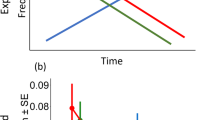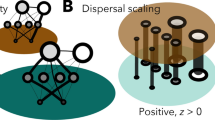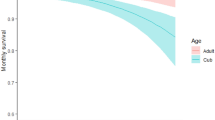Abstract
Large oscillations in the populations of Norwegian lemmings have mystified both professional ecologists and lay public1,2,3. Ecologists suspect that these oscillations are driven by a trophic mechanism4,5: either an interaction between lemmings and their food supply, or an interaction between lemmings and their predators. If lemming cycles are indeed driven by a trophic interaction, can we tell whether lemmings act as the resource (‘prey’) or the consumer (‘predator’)? In trophic interaction models, peaks of resource density generally have a blunt, rounded shape, whereas peaks of consumer density are sharp and angular. Here we have applied several statistical tests to three lemming datasets and contrasted them with comparable data for cyclic voles. We find that vole peaks are blunt, consistent with their cycles being driven by the interaction with predators. In contrast, the shape of lemming peaks is consistent with the hypothesis that lemmings are functional predators, that is, their cycles are driven by their interaction with food plants. Our findings suggest that a single mechanism, such as interaction between rodents and predators, is unlikely to provide the ‘universal’ explanation of all cyclic rodent dynamics.
This is a preview of subscription content, access via your institution
Access options
Subscribe to this journal
Receive 51 print issues and online access
$199.00 per year
only $3.90 per issue
Buy this article
- Purchase on Springer Link
- Instant access to full article PDF
Prices may be subject to local taxes which are calculated during checkout


Similar content being viewed by others
References
Elton, C. S. Periodic fluctuations in the number of animals: their causes and effects. Br. J. Exp. Biol. 2, 119–163 (1924).
Stenseth, N. C. & Ims, R. A. in The Biology of Lemmings (eds Stenseth, N. C. & Ims, R. A.) 3–34 (Linnean Society, London, 1993).
Chitty, D. Do Lemmings Commit Suicide? Beautiful Hypothesis and Ugly Facts (Oxford Univ. Press, New York, 1996).
Stenseth, N. C. & Ims, R. A. in The Biology of Lemmings (eds Stenseth, N. C. & Ims, R. A.) 61–96 (Linnean Society, London, 1993).
Stenseth, N. C., Chan, K. S., Framstad, E. & Tong, H. Phase- and density-dependent population dynamics in Norwegian lemmings: interaction between deterministic and stochastic processes. Proc. R. Soc. Lond. B 265, 1957–1968 (1998).
Rosenzweig, M. L. & MacArthur, R. H. Graphical representation and stability conditions of predator-prey interaction. Am. Nat. 97, 209–223 (1963).
May, R. M. in Theoretical Ecology: Principles and Applications (ed. May, R. M.) 78–104 (Sinauer Associates, Sunderland, Massachusetts, 1981).
Bazykin, A. D., Berezovskaya, F. S., Denisov, G. A. & Kuznetsov, Y. A. The influence of predator saturation effect and competition among predators on predator-prey system dynamics. Ecol. Mod. 14, 39–57 (1981).
Beddington, J. R., Free, C. A. & Lawton, J. H. Dynamic complexity in predator–prey model framed in simple difference equations. Nature 225, 58–60 (1976).
Oksanen, L. Exploitation ecosystems in seasonal environments. Oikos 57, 14–24 (1990).
Hanski, I., Turchin, P., Korpimäki, E. & Henttonen, H. Population oscillations of boreal rodents: regulation by mustelid predators leads to chaos. Nature 364, 232–235 (1993).
Turchin, P. & Hanski, I. An empirically-based model for the latitudinal gradient in vole population dynamics. Am. Nat. 149, 842–874 (1997).
Turchin, P. & Batzli, G. Availability of food and the population dynamics of arvicoline rodents. Ecology (in the press).
Oksanen, L. & Oksanen, T. Long-term microtine dynamics in north fennoscandian tundra—the vole cycle and the lemming chaos. Ecography 15, 226–236 (1992).
Turchin, P. Chaos and stability in rodent population dynamics: evidence from nonlinear time-series analysis. Oikos 68, 167–172 (1993).
Ostfeld, R. S., Canham, C. D. & Pugh, S. R. Intrinsic density-dependent regulation of vole populations. Nature 366, 259–261 (1993).
Oksanen, L., Fretwell, S. D., Arruda, J. & Niemela, P. Exploitation ecosystems in gradients of primary productivity. Am. Nat. 118, 240–261 (1981).
Batzli, G. O., White, R. G., MacLean, S. F., Pitelka, F. A. & Collier, B. D. in An arctic ecosystem: the coastal tundra at Barrow, Alaska. (eds Brown, J., Miller, P. C., Tieszen, L. L. & Bunnell, F. L.) 335–410 (Hutchinson and Ross, Stroudsburg, PA, 1980).
Chernyavsky, F. B. & Tkachev, A. V. Population Cycles of Lemmings in the Arctic: Ecological and Endocrine Aspects (in Russian) (Nauka, Moscow, Russia, 1982).
Moen, J., Lundberg, P. A. & Oksanen, L. Lemming grazing on snowbed vegetation during a population peak. Arctic Alpine Res. 25, 130–135 (1993).
Henttonen, H. & Kaikusalo, A. in The Biology of Lemmings (eds Stenseth, N. C. & Ims, R. A.) 157–186 (Academic, London, 1993).
Hansson, L. & Henttonen, H. Gradients in density variations of small rodents: the importance of latitude and snow cover. Oecologia 67, 394–402 (1985).
Hanski, I., Hansson, L. & Henttonen, H. Specialist predators, generalist predators, and the microtine rodent cycle. J. Anim. Ecol. 60, 353–367 (1991).
Hanski, I., Henttonen, H., Korpimäki, E., Oksanen, L. & Turchin, P. Small rodent dynamics and predation. Ecology (in the press).
Korpimäki, E. & Norrdahl, K. Experimental reduction of predators reverses the crash phase os small-rodent cycles. Ecology 79, 2448–2455 (1998).
Henttonen, H. & Hanski, I. in Chaos in Real Data (eds Perry, J. N., Smith, R. H., Woiwod, I. P. & Morse, D.) 73–96 (Kluwer Academic, Dordrecht, Netherlands, 2000).
Ekerholm, P., Oksanen, L. & Oksanen, T. Long-term dynamics of voles and lemmings in low arctic tundra and above the willow limit as a test of theories on trophic interactions. Ecography (in the press).
Framstad, E., Stenseth, N. C., Bjørnstad, O. N. & Falck, W. Limit cycles in Norwegian lemmings: tensions between phase-dependence and density dependence. Proc. R. Soc. Lond. B 264, 31–38 (1997)..
Henttonen, H., Kaikusalo, A., Tast, J. & Viitala, J. Interspecific competition between small rodents in subarctic and boreal ecosystems. Oikos 29, 581–590 (1977).
Virtanen, R., Henttonen, H. & Laine, K. M. Lemming grazing and the structure of snowbed plant community—a long-term experiment at Kilpisjärvi, in Finnish Lapland. Oikos 79, 155–166 (1997).
Acknowledgements
We thank I. Hanski and N. C. Stenseth for valuable discussion and comments on the manuscript.
Author information
Authors and Affiliations
Corresponding author
Rights and permissions
About this article
Cite this article
Turchin, P., Oksanen, L., Ekerholm, P. et al. Are lemmings prey or predators?. Nature 405, 562–565 (2000). https://doi.org/10.1038/35014595
Received:
Accepted:
Issue Date:
DOI: https://doi.org/10.1038/35014595
This article is cited by
-
Resources and predation: drivers of sociality in a cyclic mesopredator
Oecologia (2022)
-
Snow mediates climatic impacts on Arctic herbivore populations
Polar Biology (2021)
-
A beacon of dung: using lemming (Lemmus lemmus) winter nests and DNA analysis of faeces to further understand predator–prey dynamics in Northern Sweden
Polar Biology (2021)
-
Population cycles and outbreaks of small rodents: ten essential questions we still need to solve
Oecologia (2021)
-
Seasonal difference in temporal transferability of an ecological model: near-term predictions of lemming outbreak abundances
Scientific Reports (2018)
Comments
By submitting a comment you agree to abide by our Terms and Community Guidelines. If you find something abusive or that does not comply with our terms or guidelines please flag it as inappropriate.



